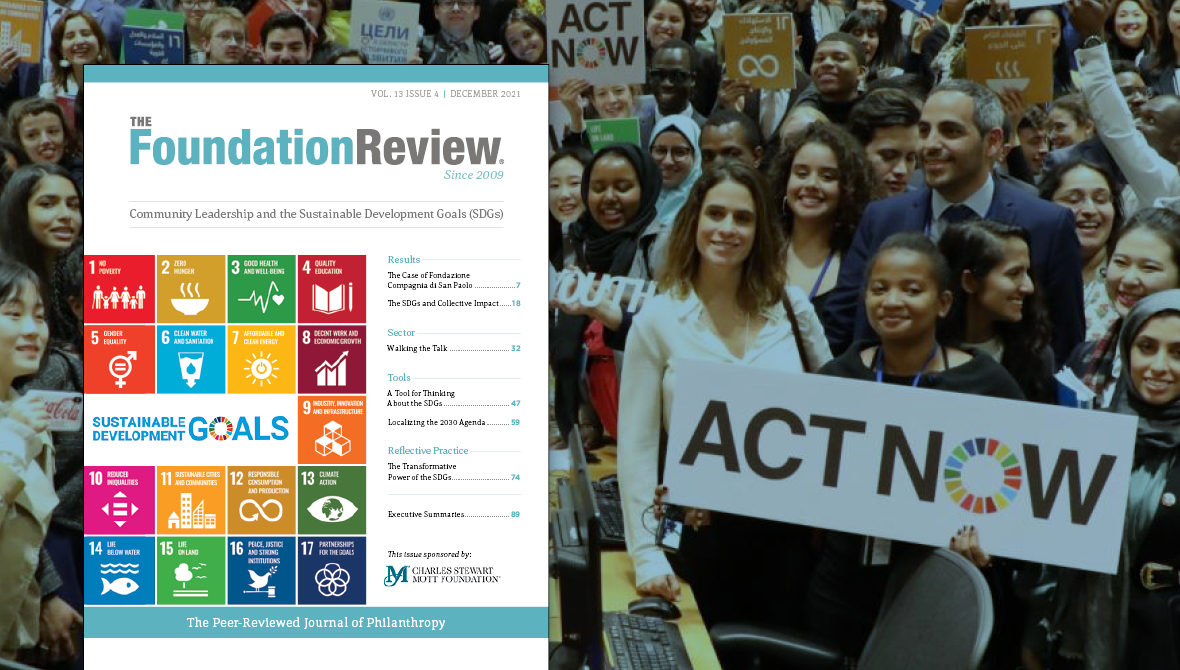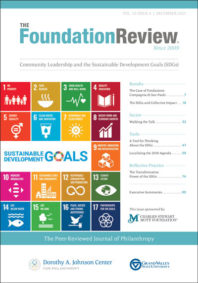Community Leadership and the Sustainable Development Goals


 In the latest issue of The Foundation Review, we focus on the United Nations’ Sustainable Development Goals (SDGs) and how they can be used as tools for community leadership.
In the latest issue of The Foundation Review, we focus on the United Nations’ Sustainable Development Goals (SDGs) and how they can be used as tools for community leadership.
The SDGs, based on five pillars for sustainable development (economic, social, environmental, cultural, security), acknowledge that sustainable development needs to happen everywhere and that inequality exists within all communities. As such, the SDGs are meant to be implemented in all nations, with a focus on community-level actions and indicators that are meant to ensure that no one is left behind.
Perhaps because of their origin with the United Nations, the Sustainable Development Goals may be seen by U.S.-based foundations as applying to developing countries, not to them and the communities they serve. The articles in volume 13, issue 4 demonstrate that the SDGs are a robust blueprint for any philanthropist concerned about the many global challenges we all face.
In this article, the authors provide a case study of how Fondazione Compagnia di San Paolo applied the Sustainable Development Goals to fundamentally restructure its operation. The foundation, whose roots go back centuries, reorganized its operations around the SDGs in 2020 as they also began functioning as an operating foundation. Framing their work around the SDGs has allowed the foundation to better align its work internally, with grantees, and with other community efforts.
One of the more widely known approaches to community change over the past decade has been collective impact. LeSage, Timur, and Pawlicki describe how the SDGs provided a useful framework on which to design, evaluate, and communicate a collective impact initiative. They provide a case study of the FutureMakers Coalition, a collective impact initiative launched by the Southwest Florida Community. They used the SDGs to help build consensus among 251 active partners on how to measure progress toward the coalition’s shared goal.
Many Canadian community foundations have adopted the SDGs. In this article, the authors provide a global and national context to the adoption of the Sustainable Development Goals by Canadian community foundations through a multiple-case study. Social innovation at the grassroots level was diffused by the Community Foundations of Canada to its member foundations to promote adoption. Prior collaborative relationships, including data collection, and the space for local adaptation were key to successful adoption. Community foundations have found adopting the SDGs supports new partnerships and coherent strategy development.
This article’s authors explore the use of a point-of-entry wheel to create a shared language that can help community foundations align their local efforts with the global goals. Collaboratory developed the wheel to provide a visualization of how the SDG framework support integration of sustainability across the foundation. They found that the process of SDG alignment made its local philanthropic work more coherent, relevant, and adaptable over time. The foundation also identified areas where further peer-learning between practitioners in the field is needed to refine approaches and processes and to build philanthropic capacity around the global goals.
Timmers and Sidney analyze the critical role that community indicators can play in helping community foundations to address the complex societal and environmental challenges embodied in the SDGs. Measurement is an integral component of Agenda 2030 and the SDGs, and communities are increasingly using indicators to align their plans, inform granting decisions, and track equity and sustainability outcomes. This article highlights case studies from three community foundations in Canada that have aligned other community indicators and associated programming with the SDGs to coordinate community action.
The West Central Initiative, a mostly rural community foundation and regional development organization in Minnesota, integrated the United Nations 17 Sustainable Development Goals into its strategic plan in 2019. In this article, the authors describe the strategic planning process that led to the adoption of the goals, articulate how they have helped evolve the interplay of economic development and philanthropy, and identify lessons learned from the first two years of working with the goals. They argue that the SDGs provide a vision for what sustainable, inclusive communities should look like.
Explore the full issue here. Not yet a subscriber? Click here to start your free 90-day trial.